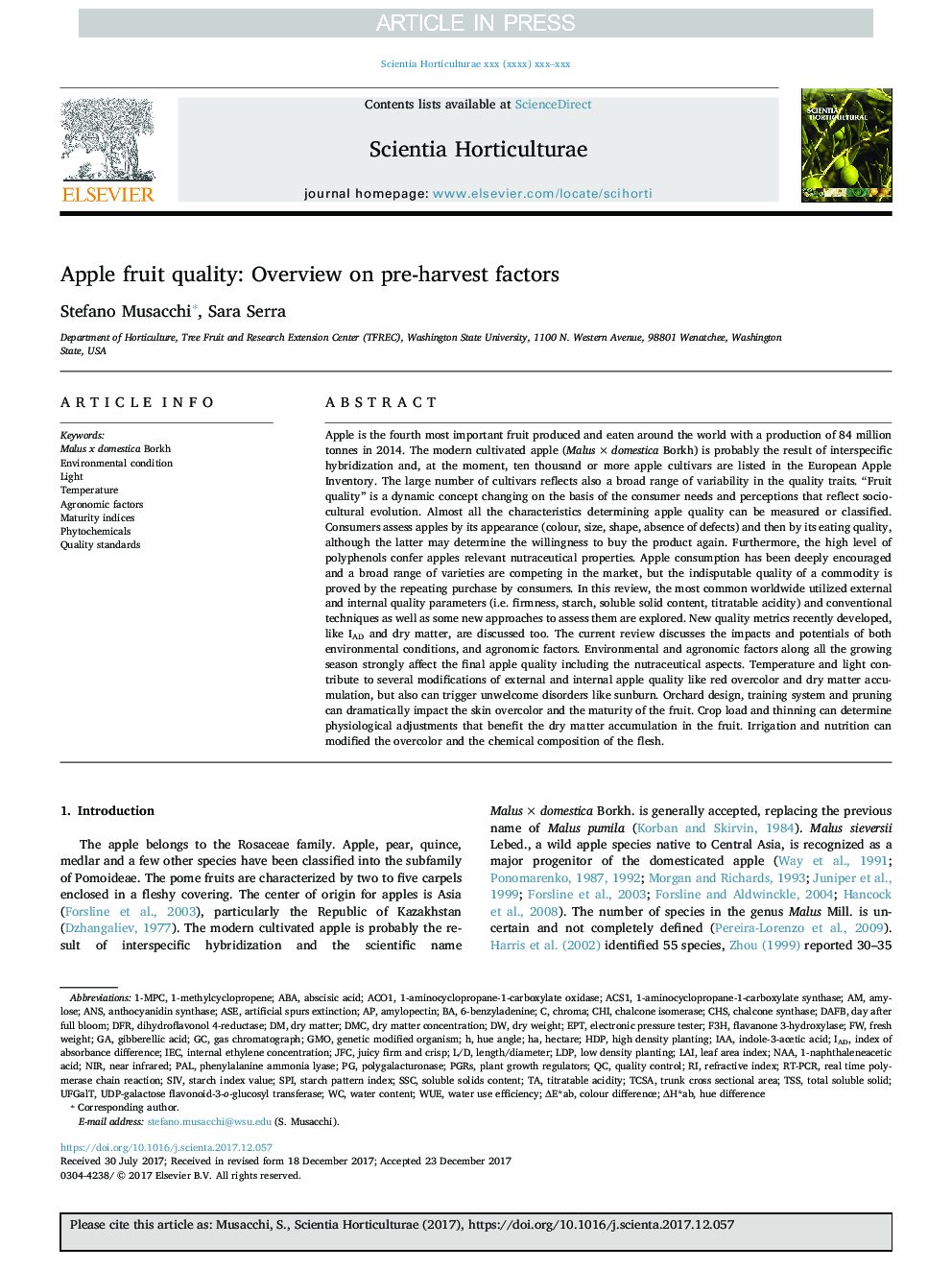| کد مقاله | کد نشریه | سال انتشار | مقاله انگلیسی | نسخه تمام متن |
|---|---|---|---|---|
| 8892800 | 1628764 | 2018 | 22 صفحه PDF | دانلود رایگان |
عنوان انگلیسی مقاله ISI
Apple fruit quality: Overview on pre-harvest factors
ترجمه فارسی عنوان
کیفیت میوه اپل: بررسی اجمالی بر عوامل پیش
دانلود مقاله + سفارش ترجمه
دانلود مقاله ISI انگلیسی
رایگان برای ایرانیان
کلمات کلیدی
DFRCHIIADCHSASEHDPPALSSCRT-PCRDAFBF3HACS1Aco1PolygalacturonaseSIVTCSAinternal ethylene concentrationLDPGMOPGRsEPTNaASPINIRWUEMalus x domestica BorkhABATSSIAADMC1-aminocyclopropane-1-carboxylate oxidase - 1-آمینوسیلیکوپروپان-1-کربوکسیلات اکسیداز1-aminocyclopropane-1-carboxylate synthase - 1-آمینوسیلیکوپروپان-1-کربوکسیلات سنتاز1-methylcyclopropene - 1-متیل سیکلوپروپین1-naphthaleneacetic acid - 1-نفتالین اسیدهای اسید6-benzyladenine - 6-بنزیل آدنینL/D - L / DAmylose - آمیلوزamylopectin - آمیلوپکتینQuality Standards - استانداردهای کیفیتindole-3-acetic acid - اسید Indole-3-استیکabscisic acid - اسید آبسزیکtitratable acidity - اسیدیته قابل تیتراسیونWater use efficiency - بهره وری استفاده از آبColour difference - تفاوت رنگPlant growth regulators - تنظیم کننده های رشد گیاهیTotal soluble solid - جامد محلول جامدgibberellic acid - جیبرلیک اسیدTemperature - دماdihydroflavonol 4-reductase - دی هیدروفلوانول 4-ردوکتازhue angle - زاویه رنگANS - سالanthocyanidin synthase - سنتاز آنتوسیانیدینchalcone synthase - سنتاز چالکونLeaf area index - شاخص سطح برگMaturity indices - شاخص های بلوغLAI - شبیهEnvironmental condition - شرایط محیطیRefractive index - ضریب شکستflavanone 3-hydroxylase - فلاونون 3-هیدروکسیلازPhenylalanine ammonia lyase - فنیل آلانین آمونیاک لیائازPhytochemicals - فیتوکمیکال هاdry matter - ماده خشکNear infrared - مادون قرمز نزدیکWater content - محتوای آبsoluble solids content - محتوای جامد محلولlight - نور hectare - هکتارReal time polymerase chain reaction - واکنش زنجیره ای پلیمراز واقعی در زمان واقعیfresh weight - وزن ترdry weight - وزن خشکchroma - کرومgas chromatograph - کروماتوگرافی گازchalcone isomerase - کلومون ایزومرازIEC - کمیسیون مستقل انتخاباتquality control - کنترل کیفیت
موضوعات مرتبط
علوم زیستی و بیوفناوری
علوم کشاورزی و بیولوژیک
دانش باغداری
چکیده انگلیسی
Apple is the fourth most important fruit produced and eaten around the world with a production of 84 million tonnes in 2014. The modern cultivated apple (Malusâ¯Ãâ¯domestica Borkh) is probably the result of interspecific hybridization and, at the moment, ten thousand or more apple cultivars are listed in the European Apple Inventory. The large number of cultivars reflects also a broad range of variability in the quality traits. “Fruit quality” is a dynamic concept changing on the basis of the consumer needs and perceptions that reflect sociocultural evolution. Almost all the characteristics determining apple quality can be measured or classified. Consumers assess apples by its appearance (colour, size, shape, absence of defects) and then by its eating quality, although the latter may determine the willingness to buy the product again. Furthermore, the high level of polyphenols confer apples relevant nutraceutical properties. Apple consumption has been deeply encouraged and a broad range of varieties are competing in the market, but the indisputable quality of a commodity is proved by the repeating purchase by consumers. In this review, the most common worldwide utilized external and internal quality parameters (i.e. firmness, starch, soluble solid content, titratable acidity) and conventional techniques as well as some new approaches to assess them are explored. New quality metrics recently developed, like IAD and dry matter, are discussed too. The current review discusses the impacts and potentials of both environmental conditions, and agronomic factors. Environmental and agronomic factors along all the growing season strongly affect the final apple quality including the nutraceutical aspects. Temperature and light contribute to several modifications of external and internal apple quality like red overcolor and dry matter accumulation, but also can trigger unwelcome disorders like sunburn. Orchard design, training system and pruning can dramatically impact the skin overcolor and the maturity of the fruit. Crop load and thinning can determine physiological adjustments that benefit the dry matter accumulation in the fruit. Irrigation and nutrition can modified the overcolor and the chemical composition of the flesh.
ناشر
Database: Elsevier - ScienceDirect (ساینس دایرکت)
Journal: Scientia Horticulturae - Volume 234, 14 April 2018, Pages 409-430
Journal: Scientia Horticulturae - Volume 234, 14 April 2018, Pages 409-430
نویسندگان
Stefano Musacchi, Sara Serra,
